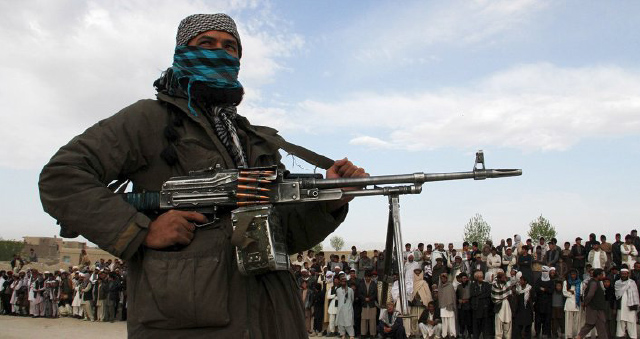The invasion of Afghanistan was intended to topple the Taliban regime that had ruled most of the country since 1996 and supported al-Qaeda and to counter terrorism. The Taliban, which had imposed its stereotypical ideology on the entire country, perpetrated countless human rights abuses against its people, especially women, girls and ethnic minorities. During their rule, large numbers of Afghans lived in utter poverty, and as many as four million Afghans are thought to have suffered from starvation.
The US military forces overthrew the Taliban government and disrupted bin Laden’s Al-Qaeda network. On May 2, 2011, bin Laden was killed by United States Armed Forces in Pakistan. The Taliban leadership survives in hiding throughout Afghanistan and Pakistan and continues to launch guerrilla attacks against the foreign forces and the current government.
Even as Afghanistan began to take the first steps toward democracy, the Taliban insurgents began to regroup in the mountainous border region between Afghanistan and Pakistan. They continue to engage US and Afghan troops in guerilla-style warfare and have also been responsible for the deaths of elected government officials and aid workers and the kidnapping of foreigners. Hundreds of American and coalition soldiers and thousands of Afghans have been killed and wounded in the fighting.
Afghans continue to make up the second largest refugee population in the world, though around 3 million have returned to Afghanistan since the fall of the Taliban, further straining the country’s war-ravaged economy. With the establishment of National Unity Government (NUG), Afghans face further economic stagnation, unemployment and political crisis and therefore, a larger number of Afghan families, especially the youth, emigrate from the country.
A journalist writes, “The Kabul regime is in a state of panic over the Taliban’s current offensive which led to the first major city to fall into their hands since 2002, the capture of a dozen district headquarters and the group’s extensive territorial gains across the country. The situation has further increased the outflow of young Afghans joining the migrant rush to reach Germany.”
Since the security was handed from NATO to Afghan forces and the strategy of “war on terror” was proved abortive, Afghan soldiers encountered great challenges in countering terrorism on their own. Afghan combatants and non-combatants suffered heavy casualties and security still remains elusive. As a result, between 1 January and 31 March, UNAMA documented 1,810 civilian casualties, a two per cent decrease from the same period in 2014.
Currently, the emergence of the self-styled Islamic State (IS) group is a new challenge ahead of NUG and Afghan soldiers. There are reports that the IS militant group is recruiting children in Afghanistan and brainwash them to use as a vehicle for their political interests. So far, however, IS has been led by minor disgruntled Taliban figures who first made their disaffection known in January 2015. In a propaganda video released soon after they pledged allegiance to IS, a little-known former Talib, Hafiz Saeed Khan, was appointed by IS as the governor of the newly named Khorasan Province that includes Pakistan, Afghanistan and parts of Central Asia.
His deputy, Mullah Abdul Rauf Khadim from Helmand province in the south, was soon killed by a US drone strike while IS recruiting cells were also set up in Farah province in the west and in northern Afghanistan.
Moreover, significant Central Asian groups such as the Islamic Movement of Uzbekistan (IMU), which had been devotedly fighting for the Taliban for two decades, decided to pledge loyalty to IS, although that did not stop them from joining the Taliban in their assault on Kunduz.
Afghan and foreign media reports claim that IS is making steady military gains capturing territory, recruiting Taliban fighters to their cause, spending large amounts of cash while carrying out horrendous punishments for those opposing them.
IS now has competition from both the rejuvenated Taliban and al-Qaeda. Mullah Mansoor wrote a blistering letter to IS leaders in Baghdad in June telling them to stop interfering in Afghanistan and that “jihad against American invaders and their slaves in Afghanistan must be under one flag, one leadership and one command”.
“With its forces straining to combat a spreading insurgency, the Afghan government is partly outsourcing the war to irregular militias, many of them US-funded, even as President Ashraf Ghani has pledged to disarm them. As a result, new strongmen have emerged while established ones have grown more powerful.”
Rather than having protection from the militias, the people encounter problems with their presence. Human rights activists have accused the pro-government militias of extrajudicial killings, rapes, torture, kidnappings and drug trafficking. Although the militias are nowhere near as deadly as the Taliban, last year the United Nations recorded that they killed 53 civilians, nearly triple the number in 2013.
The political and economic challenges have badly plagued Afghan nation. The Taliban’s spring offensive and their leader’s death, Mullah Omar, spoiled the peace talk and the IS’s language is the barrel of gun. Although, the government officials still seem to be willing to tackle the security crisis through negotiation, but this way has been tried repeatedly and failed to give the desired result. Additionally, the IS group is more fundamental and inflexible and therefore, military deal is the only effective strategy to counter it. To overcome the challenges, the government has to reinforce the Afghan soldiers.

